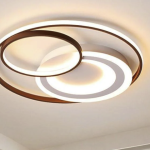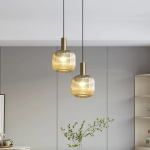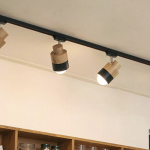
When it comes to lighting nushliving your home, there are many options to choose from. One of the most common debates is whether to use floor lamps or ceiling lamps. Both options have their advantages and disadvantages, and the choice ultimately depends on your personal preferences and the specific needs of your space. In this article, we will explore the pros and cons of floor lamps and ceiling lamps, as well as provide tips on how to choose the right lighting solution for your home.
Understanding the Role of Lighting in Home Décor
Before diving into the floor vs. ceiling lamp debate, it is important to understand the role of lighting in home décor. Lighting plays a crucial role in creating a comfortable and inviting atmosphere in your home. It can enhance the overall aesthetic appeal of a space, highlight architectural features, and set the mood for different activities.
Proper lighting can make a small room appear larger, while inadequate lighting can make a large room feel cold and unwelcoming. It is important to strike a balance between natural and artificial light sources to create a harmonious and functional space. By carefully selecting the right lighting fixtures, you can transform your home into a warm and inviting sanctuary.
Advantages and Disadvantages of Floor Lamps
Floor lamps are versatile lighting fixtures that can be easily moved around to suit your needs. They come in various styles, sizes, and designs, making it easy to find one that complements your home décor. One of the main advantages of floor lamps is their ability to provide task lighting in specific areas of a room. Whether you need extra light for reading, working, or doing crafts, a floor lamp can be positioned next to your favorite chair or desk to provide focused illumination.
Another advantage of floor lamps is their ability to create ambient lighting. By placing a floor lamp in a corner or behind furniture, you can create a soft and diffused glow that adds warmth and depth to a room. Floor lamps also offer the flexibility to adjust the height and angle of the light source, allowing you to direct the light where it is needed most.
However, there are also some disadvantages to consider when using floor lamps. One of the main drawbacks is that they take up valuable floor space. If you have a small room or limited floor space, a floor lamp may not be the best option as it can make the space feel cluttered and cramped. Additionally, floor lamps can be a tripping hazard, especially if you have children or pets in your home.
Advantages and Disadvantages of Ceiling Lamps
Ceiling lamps, also known as overhead lighting fixtures, are a popular choice for many homeowners. They provide general illumination to a room and can be used as the primary light source. Ceiling lamps come in various styles, including chandeliers, pendant lights, flush mount lights, and track lighting.
One of the main advantages of ceiling lamps is their ability to provide even and uniform lighting throughout a room. Unlike floor lamps, which can create shadows and uneven lighting, ceiling lamps distribute light evenly across the entire space. This makes them ideal for rooms that require bright and consistent lighting, such as kitchens, bathrooms, and home offices.
Ceiling lamps also have the advantage of being out of the way and not taking up any floor space. This is especially beneficial in small rooms where every inch of space counts. Additionally, ceiling lamps can be more aesthetically pleasing as they are often considered a focal point in a room. A well-designed ceiling lamp can add a touch of elegance and sophistication to your home décor.
However, there are also some disadvantages to using ceiling lamps. One of the main drawbacks is that they require professional installation, especially if you want to install recessed lighting or track lighting. This can be costly and time-consuming, especially if you need to hire an electrician. Additionally, ceiling lamps are not as flexible as floor lamps when it comes to adjusting the direction and intensity of the light. Once installed, the position and angle of the light source cannot be easily changed.
Factors to Consider When Choosing Between Floor and Ceiling Lamps
When deciding between floor and ceiling lamps, there are several factors that should be taken into consideration. These include the size and layout of the room, the specific lighting needs, and personal preferences.
Room size: The size of the room plays a crucial role in determining whether to use floor or ceiling lamps. In small rooms, floor lamps can take up valuable floor space and make the room feel cluttered. In this case, ceiling lamps may be a better option as they do not take up any floor space. On the other hand, in large rooms with high ceilings, ceiling lamps may not provide enough light to adequately illuminate the entire space. In this case, floor lamps can be used to supplement the overhead lighting and provide additional task or ambient lighting.
Layout: The layout of the room also influences the choice between floor and ceiling lamps. If you have a specific area in the room that requires focused lighting, such as a reading nook or a desk, a floor lamp can be positioned next to it to provide task lighting. On the other hand, if you have an open-concept layout where multiple activities take place in one space, ceiling lamps may be more suitable as they provide general illumination to the entire area.
Lighting needs: Consider your specific lighting needs when choosing between floor and ceiling lamps. If you require bright and consistent lighting throughout a room, ceiling lamps may be the best option. However, if you need flexibility in adjusting the direction and intensity of the light, floor lamps may be more suitable.
Personal preferences: Ultimately, your personal preferences should guide your decision. Consider your overall home décor style and choose a lighting solution that complements it. Additionally, think about the atmosphere you want to create in each room and choose a lighting fixture that helps achieve that.
Matching Your Lighting Solution to Your Room Size and Layout

Choosing the right type of lamp for different room sizes and layouts is crucial to ensure optimal lighting. In small rooms, it is important to maximize the use of space and avoid clutter. In this case, ceiling lamps are often the best choice as they do not take up any floor space. Recessed lighting or track lighting can be installed to provide even and consistent lighting throughout the room.
In larger rooms with high ceilings, ceiling lamps may not provide enough light to adequately illuminate the entire space. In this case, floor lamps can be used to supplement the overhead lighting and provide additional task or ambient lighting. Place floor lamps strategically in corners or next to furniture to create a warm and inviting atmosphere.
For rooms with an open-concept layout where multiple activities take place in one space, a combination of floor and ceiling lamps may be the best solution. Ceiling lamps can provide general illumination to the entire area, while floor lamps can be used to create focused lighting in specific areas. This allows for flexibility in adjusting the lighting according to different activities and moods.
Choosing the Right Lamp Style to Suit Your Home Décor
When choosing between floor and ceiling lamps, it is important to consider the style of your home décor. Lighting fixtures should complement the overall aesthetic appeal of your space and enhance its visual appeal. There are various lamp styles to choose from, including modern, traditional, industrial, rustic, and minimalist.
If you have a modern or contemporary home décor style, sleek and minimalist floor lamps or pendant lights can be a great choice. These types of lamps often feature clean lines, geometric shapes, and neutral colors. They can add a touch of sophistication and elegance to your space without overpowering the overall design.
For a more traditional or classic home décor style, chandeliers or table lamps with ornate details and intricate designs can be a great choice. These types of lamps often feature decorative elements such as crystals, beads, and tassels. They can add a touch of elegance and grandeur to your space.
If you have an industrial or rustic home décor style, floor lamps or pendant lights with exposed bulbs and metal accents can be a great choice. These types of lamps often feature raw and unfinished materials such as wood, metal, and concrete. They can add a touch of ruggedness and authenticity to your space.
When choosing the right lamp style, it is important to consider the overall color scheme and materials used in your home décor. Choose lamps that complement the existing color palette and materials to create a cohesive and harmonious look.
Maximizing Energy Efficiency with Your Lighting Choice
In addition to aesthetics and functionality, it is important to consider energy efficiency when choosing between floor and ceiling lamps. Energy-efficient lighting not only helps reduce your carbon footprint but also saves you money on energy costs in the long run. Here are some tips on how to choose energy-efficient lamps and how to use them to save on energy costs:
– Choose LED bulbs: LED bulbs are the most energy-efficient option available on the market. They use up to 80% less energy than traditional incandescent bulbs and last up to 25 times longer. LED bulbs also produce less heat, making them safer to use.
– Look for ENERGY STAR certified lamps: ENERGY STAR certified lamps meet strict energy efficiency guidelines set by the U.S. Environmental Protection Agency (EPA). These lamps use up to 90% less energy than standard models without sacrificing performance or quality.
– Use dimmers and timers: Dimmers and timers allow you to control the intensity and duration of the light, helping you save on energy costs. Dimming the lights by just 10% can save up to 20% on energy costs.
– Take advantage of natural light: Make use of natural light during the day by opening curtains and blinds. This not only reduces the need for artificial lighting but also provides a connection to the outdoors and boosts mood and productivity.
– Use task lighting: Instead of relying on overhead lighting to illuminate an entire room, use task lighting to provide focused illumination where it is needed most. This helps reduce energy consumption by only lighting up specific areas.
Tips for Maintenance and Care of Your Floor or Ceiling Lamp
Proper maintenance and care are essential to ensure the longevity of your floor or ceiling lamp. Here are some tips on how to properly maintain and care for your lighting fixtures:
– Clean regularly: Dust and dirt can accumulate on lampshades, bulbs, and other parts of the lamp, affecting its performance and appearance. Clean your lamps regularly using a soft cloth or duster. Avoid using abrasive cleaners or harsh chemicals as they can damage the finish.
– Replace bulbs when needed: Regularly check the bulbs in your lamps and replace them when they burn out. Using old or faulty bulbs can affect the performance of the lamp and may even pose a safety hazard.
– Check electrical connections: Periodically check the electrical connections of your lamps to ensure they are secure and in good condition. Loose or damaged connections can cause flickering lights or even electrical shocks.
– Avoid overloading circuits: Be mindful of the wattage of the bulbs you use in your lamps and avoid overloading circuits. Using bulbs with higher wattage than recommended can cause overheating and may even lead to electrical fires.
– Store properly: If you need to store your lamps for an extended period, make sure to clean them thoroughly and store them in a cool, dry place. Avoid storing lamps in areas with extreme temperatures or high humidity as this can damage the electrical components.
Final Thoughts: Making the Right Choice for Your Home
Choosing between floor and ceiling lamps is a personal decision that depends on various factors such as room size, layout, lighting needs, and personal preferences. Both options have their advantages and disadvantages, and it is important to carefully consider these factors before making a decision.
Floor lamps offer flexibility in terms of positioning and adjusting the direction of the light. They can provide task lighting in specific areas and create ambient lighting in corners or behind furniture. However, they take up valuable floor space and can be a tripping hazard.
Ceiling lamps provide even and uniform lighting throughout a room. They can be used as the primary light source and do not take up any floor space. However, they require professional installation and do not offer the flexibility to adjust the direction of the light.
By considering the size and layout of your room, your specific lighting needs, and your home décor style, you can make an informed decision on whether to use floor or ceiling lamps. Remember to also prioritize energy efficiency and properly maintain and care for your lighting fixtures to ensure their longevity.




